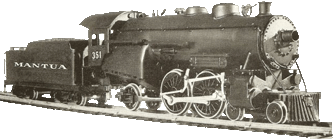|
|
 Posted - November 14 2016 : 01:43:52 AM Posted - November 14 2016 : 01:43:52 AM




|
I'm looking to chemically blacken most of the parts on a future project. I'm going to use neolube #2. I'm looking to do all the wheels and side rods. The pilot wheels and tender wheels will be totally coated and the the driver rims. What's the best way to apply this so it doesn't create short circuits? It's conductive and is very thin.
" Heck with counting 'em rivets, TRAINS ARE FOR FUN! Not called the Mad Scientist for nothing either!"
|
Country:  USA ~
Posts: 3145 ~
Member Since: May 07 2007 ~
Last Visit: April 04 2024 USA ~
Posts: 3145 ~
Member Since: May 07 2007 ~
Last Visit: April 04 2024
|
 Alert Moderator
Alert Moderator
|
|
|
|
 Posted - November 14 2016 : 01:53:38 AM Posted - November 14 2016 : 01:53:38 AM




|
I would say the best way is to not do it. I'd be worried about it impairing electrical pickup - I had to remove the blackening from a loco's wheels once because it was blocking the loco from picking up more than a trickle of power even at full throttle.
Feedback-hungry attention w****
|
Country:  USA ~
Posts: 750 ~
Member Since: December 05 2015 ~
Last Visit: January 24 2024 USA ~
Posts: 750 ~
Member Since: December 05 2015 ~
Last Visit: January 24 2024
|
 Alert Moderator
Alert Moderator

|
|
|
|
 Posted - November 14 2016 : 08:04:13 AM Posted - November 14 2016 : 08:04:13 AM






|
quote:I would say the best way is to not do it. I'd be worried about it impairing electrical pickup - I had to remove the blackening from a loco's wheels once because it was blocking the loco from picking up more than a trickle of power even at full throttle.
Originally posted by ZeldaTheSwordsman - November 14 2016 :  01:53:38 AM
|
I second Zelda, I've had a few brand new engines come in the shop, won't run. The blackening on the wheels had bled onto the rolling surface, and impaired electrical pickup. I few minutes with the stainless steel rotary dremel brush, and cleaned off the rolling surfaces, and they worked find. Looks great, but don't get any on the rolling surface if you can help it.
Jerry
" When life throws you bananas...it's easy to slip up"
|
Country:  USA ~
Posts: 3974 ~
Member Since: January 04 2009 ~
Last Visit: January 11 2019 USA ~
Posts: 3974 ~
Member Since: January 04 2009 ~
Last Visit: January 11 2019
|
 Alert Moderator
Alert Moderator

|
|
|
|
 Posted - November 14 2016 : 08:21:24 AM Posted - November 14 2016 : 08:21:24 AM




|
I could see a possibility of a short circuit across the insulated side of the wheels. It would depend on how conductive the stuff is. It's graphite, so it's sort of a resistor. Electricity will follow the path of least resistance, so I guess it's a question of whether the motor under load represents significantly less resistance than the short across the insulator between the wheels and axles on the tender and across the wheel face on the insulated drivers.
I usually just use paint to blacken wheel faces, so I have no experience with whether Neolube is a short circuit in actual practice.
Carpe Manana!
|
Country:  USA ~
Posts: 2359 ~
Member Since: September 17 2013 ~
Last Visit: May 16 2024 USA ~
Posts: 2359 ~
Member Since: September 17 2013 ~
Last Visit: May 16 2024
|
 Alert Moderator
Alert Moderator

|
|
|
|
 Posted - November 14 2016 : 1:46:12 PM Posted - November 14 2016 : 1:46:12 PM





|
Justin,
Another way you can try is to use plain white vinegar if the metal is steel. I'm not sure if it will work on brass. Take the rods off the loco and clean off oil and grease with alcohol or dish soap and water. Heat the vinegar to a rolling boil then immerse the parts in the hot vinegar for about a half hour. Caution - don't put plastic in the hot solution as it may melt.
Richard in Vermont
|
Country:  USA ~
Posts: 42 ~
Member Since: October 31 2010 ~
Last Visit: February 05 2019 USA ~
Posts: 42 ~
Member Since: October 31 2010 ~
Last Visit: February 05 2019
|
 Alert Moderator
Alert Moderator

|
|
|
|
 Posted - November 15 2016 : 02:05:57 AM Posted - November 15 2016 : 02:05:57 AM




|
Does neolube go bad? I put some on a steam locomotive and I noticed that some of it had rubbed off, have not noticed that on my older ones that I did years ago, with the same pot that I still have. I think it is about 15 years old or older.
Modeling on the cheap
|
Country:  USA ~
Posts: 137 ~
Member Since: December 08 2015 ~
Last Visit: June 26 2017 USA ~
Posts: 137 ~
Member Since: December 08 2015 ~
Last Visit: June 26 2017
|
 Alert Moderator
Alert Moderator

|
|

